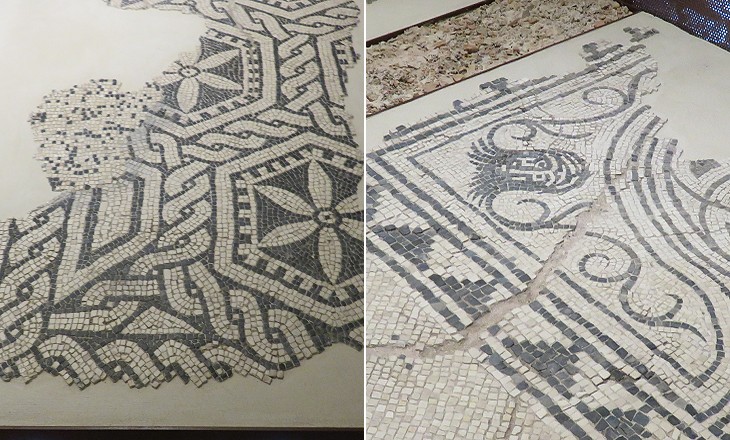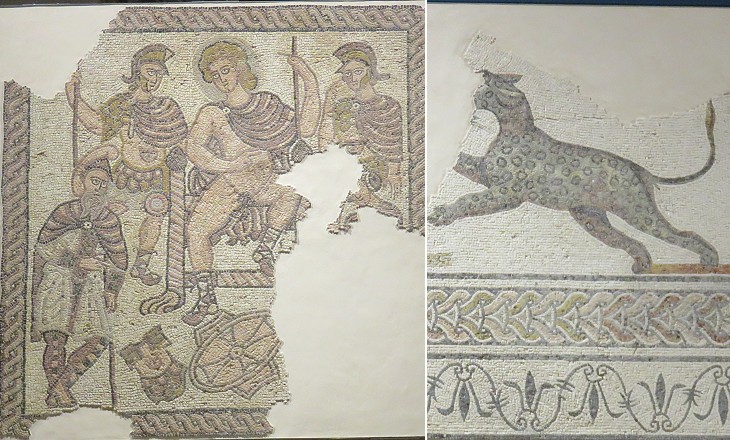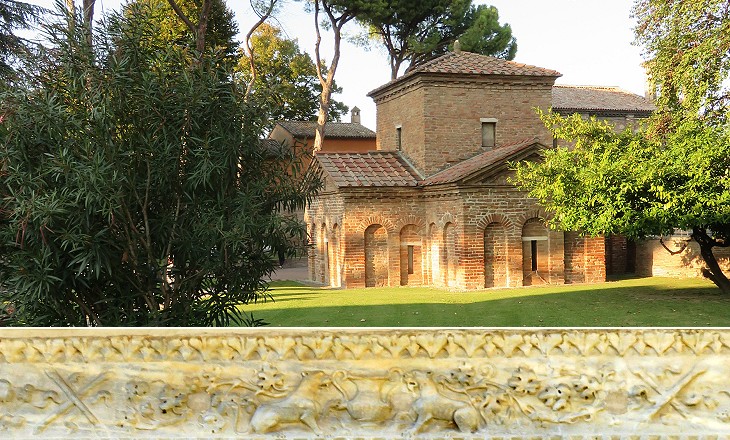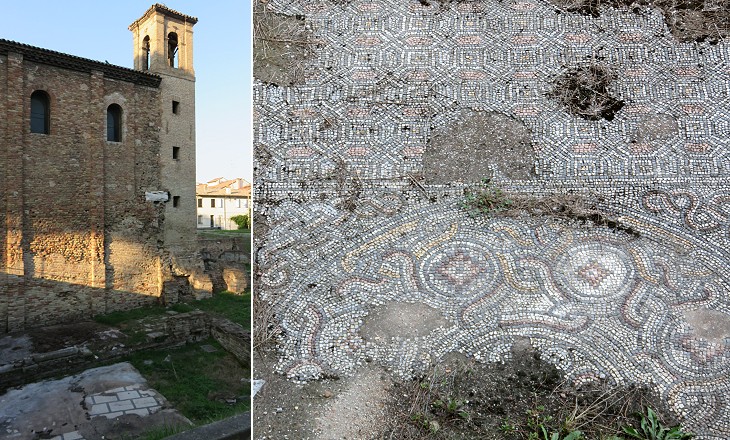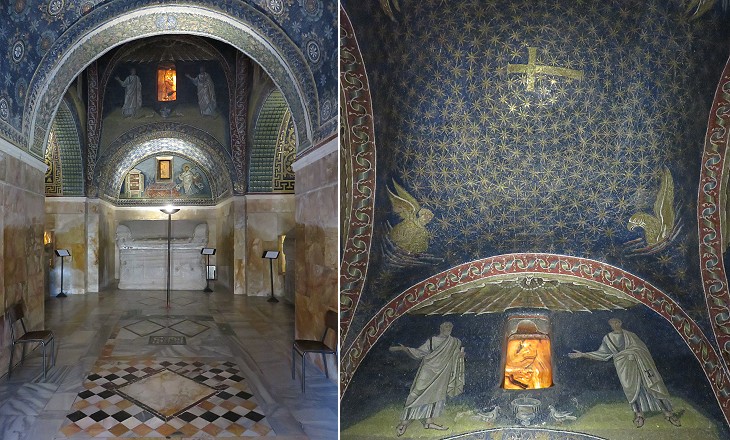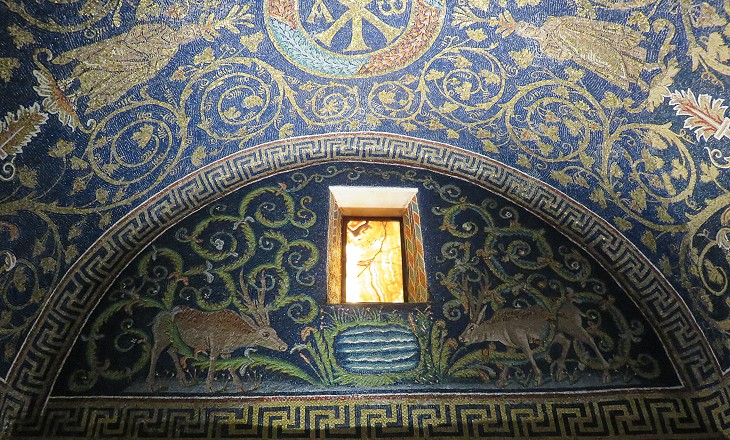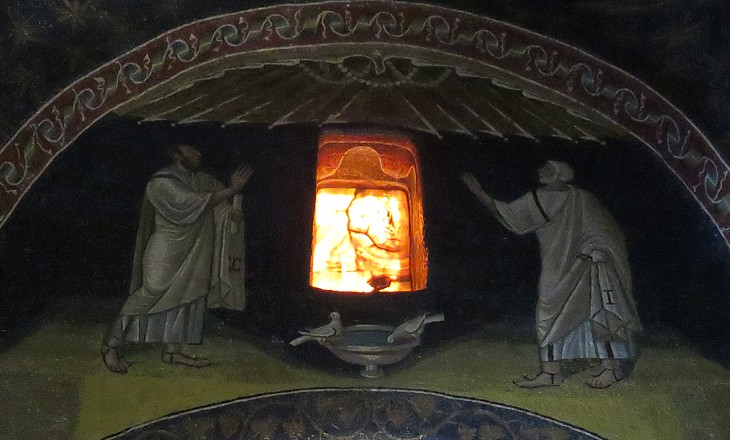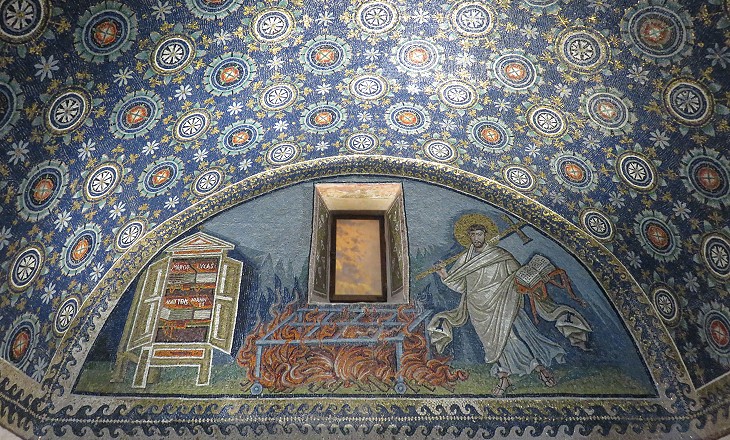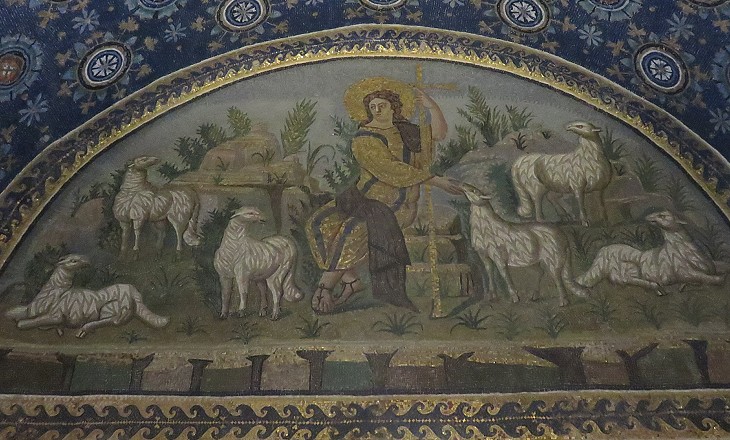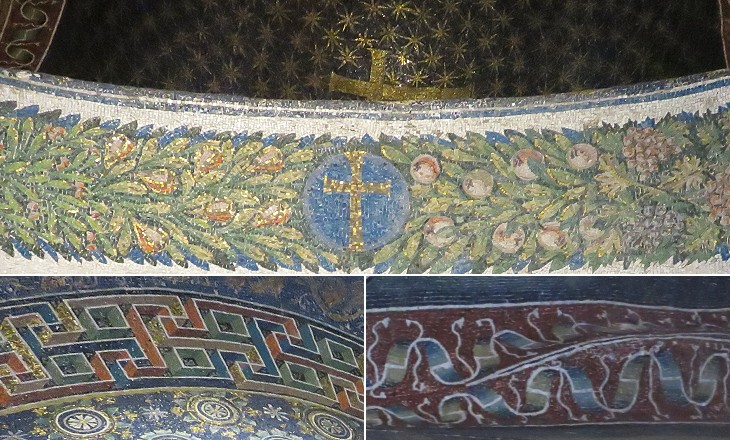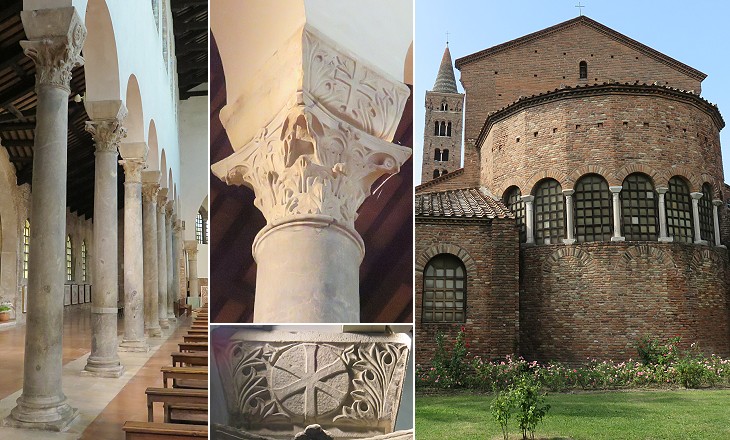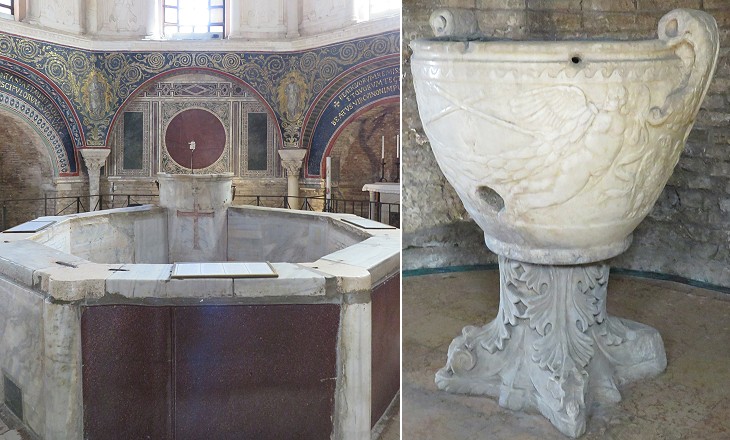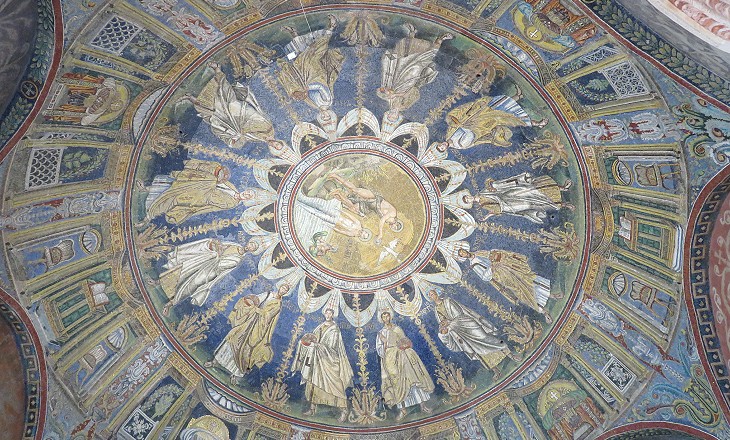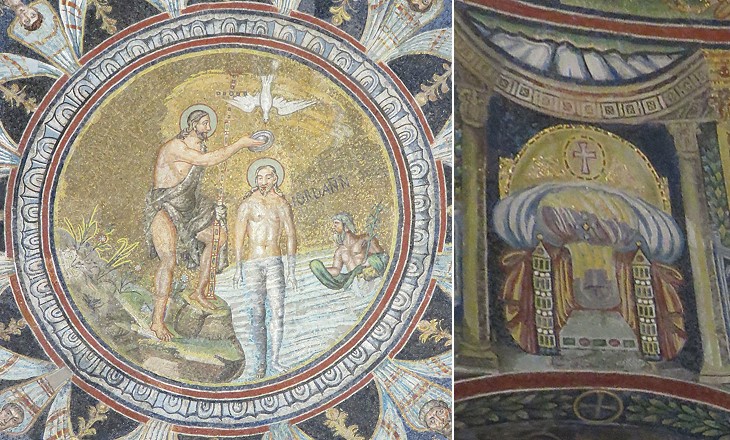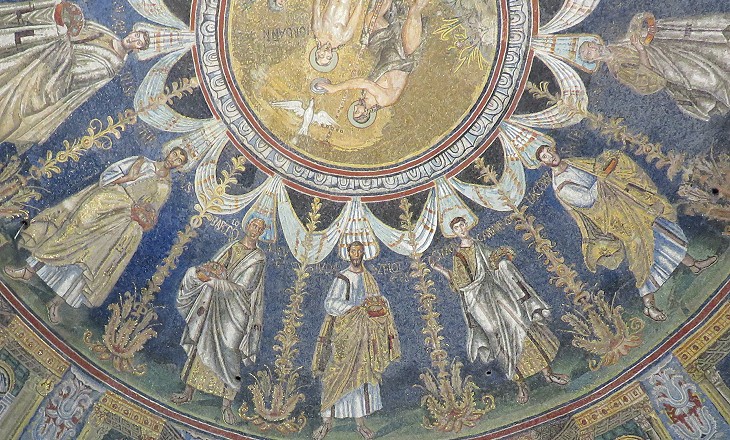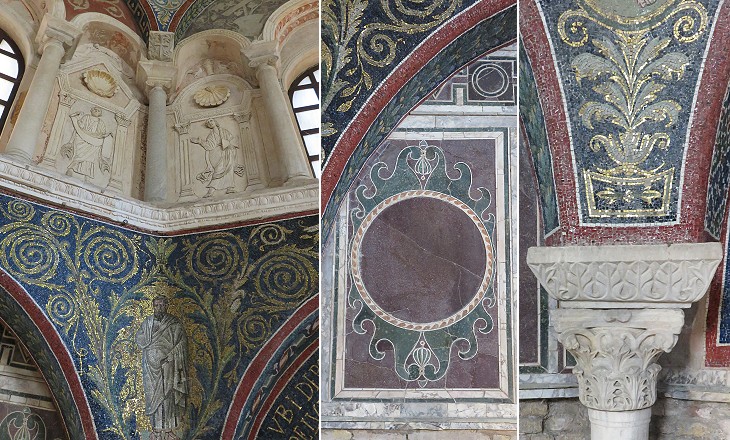  What's New! Detailed Sitemap All images © by Roberto Piperno, owner of the domain. Write to romapip@quipo.it. Text edited by Rosamie Moore. Page added in December 2014. |
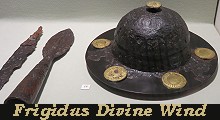 - Roman Ravenna - Roman Ravenna(Longobard weapons at Museo Archeologico di Cividale) You may wish to read an introduction to this section first.
Ancient Ravenna stood on a group of islets at the centre of a lagoon and it was much closer to the Adriatic Sea than it is today. It acquired importance in ca 27 BC when Emperor Augustus decided to build Civitas Classis (City of the Fleet), a harbour for the Roman fleet at the southern entrance to the lagoon. Fossa Augustea, a large canal, was dug to carry enough water from the River Po to the harbour to avoid its silting. Roman Ravenna was crossed by Via Popilia, a road which linked it with Ariminum (Rimini) and Aquileia. The ground upon which its buildings stood was subject to subsidence and its inhabitants were forced to gradually raise the level of their houses, so that very limited evidence has been found of the urban layout of Ravenna in the first centuries AD.
Ravenna, (..) fortress of falling empire! Lord Byron - Childe Harold's Pilgrimage - LIX In the late IVth century the lagoon surrounding Ravenna became marshy and made it very difficult to reach the town by land. This generally negative development had a positive aspect because it made Ravenna a very safe place from a military standpoint. In 402 Emperor Honorius moved his residence there from Milan. He had become Western Roman Emperor upon the death of his father Theodosius in 395, when he was a boy of ten. The actual power was held by Stilicho, magister militum (leader of the army), who managed to contain the growing threat of Gothic tribes at the borders of the Empire.
Stilicho was murdered in 408 by order of Honorius. This caused a rift in the army. Alaric, leader of the Visigoths, entered Italy and, unopposed by the Emperor, who did not move out of Ravenna, sacked Rome in 410 and took Galla Placidia, Honorius' half-sister, prisoner. In 411 or 414 she married Ataulph, Alaric's successor. In 416 Honorius assigned the provinces of south-western France to the Visigoths who established there the first of a series of foederati (allied) kingdoms, which nominally recognized the suzerainty of the Roman emperors. Ataulph was killed by another Visigoth leader and Galla Placidia returned to Ravenna where in 417 Honorius forced her to marry Flavius Costantius, another magister militum. In 421 her second husband was made co-emperor and Galla Placidia received the title of Augusta. In 425, by which time both Honorius and Costantius had died, she managed to have Valentinian III, her six-year-old son, acclaimed emperor. She was regent for her son until 437.
Today the mausoleum Galla Placidia erected for herself and her relatives is inside an enclosure which includes S. Vitale, a large church built almost a century later. Archaeologists believe that the mausoleum was a funerary chapel attached to S. Croce, a church which was larger than the current building and is now outside the enclosure. The design of the mausoleum is similar to that of the only remaining chapel of S. Maria Formosa at Pola.
Eventually Galla Placidia did not lie at rest in her mausoleum at Ravenna. She died in 450 in Rome and she was buried in a (subsequently) lost chapel of S. Pietro Vecchio. The mausoleum is both a masterpiece of mosaic making and a source of information on the transition from the Ancient World to the Early Middle Ages in terms of subjects and decorative patterns. Like the baptistery and other buildings in Ravenna this mausoleum had sunk and the floor has been raised nearly six feet, which has ruined its interior proportions. Even now the water sometimes rises from below and invades the floor. Thomas Graham Jackson - Byzantine and Romanesque Architecture - 1913 The upper part of the mausoleum is entirely covered by mosaics having a dark blue background. The decoration was based on mosaics because frescoes would have been damaged by damp. The marbles which decorate the lower part of the walls were placed there at the end of the XIXth century.
Two animals at the sides of an object is a decorative pattern used from the very beginning of civilization, but at Ravenna it was utilized with particular frequency (you might have noted it in the lintel), especially in the decoration of sarcophagi (it opens in another window). Another interesting aspect of this mosaic is the significance acquired by water as a symbol of the True Faith.
Galla Placidia promoted the completion of a mosaic at S. Paolo fuori le Mura where again the two saints were depicted as senators. In Italy St. Peter and St. Paul were often associated in mosaics, statues and paintings, in particular in their role of judges of the sinners as at Ponte Sant'Angelo. It is something which had its roots in the history of Rome having a liking for pairs (Romulus and Remus, Castor and Pollux, the two consuls, etc). In addition the two saints were symbols of the military/nobility (Paul, a Roman soldier) and the clergy (Peter, the first Bishop of Rome), the two classes which dominated Italian society until the XIXth century. This association continues to the present day and modern churches are dedicated to them jointly.
The depiction of a saint with the instrument of his/her martyrdom was made compulsory by the Roman Church in the late XVIth century (you may wish to see a page on Torture and Death in the Churches of Rome). In the Vth century however saints were not often made identifiable using this approach, but names were written next to them. The choice to depict the way St. Lawrence was killed can be explained by the fact that St. Ambrose in De Officiis Ministrorum had given a detailed account of the saint's martyrdom. St. Ambrose had a great influence over Emperor Theodosius and convinced him to persecute Paganism, a task that his daughter Galla Placidia carried on with great zeal.
The iconography of Jesus Christ in this and other later mosaics at S. Apollinare Nuovo is very different from the one we are accustomed to. He is portrayed as a young man without the beard which characterizes the usual iconography. His dress is gold and purple and his head is surrounded by a golden halo. These elements of power and divinity however did not lead the maker of the mosaic to portray Jesus in a solemn and frontal position. Our Lord as the "Pastor Bonus" is seated among his sheep, a graceful youthful figure that might have served for Orpheus or Apollo. T. G. Jackson The reference to Orpheus is very appropriate, given the great similarity between this mosaic and others portraying the taming of the animals by Orpheus (e.g. at Antioch and Philippopolis). The sheep are a metaphor. They represent Jesus' disciples and at S. Apollinare in Classe they were depicted to indicate St. Peter, St. John and St. James.
Religious symbols permeate the decoration of the mausoleum, with the exception of some details, where the maker of the mosaic showed his skill in designing a three-dimensional maze and a twisted gold and silver ribbon. (The best) place for an artist fond of dusky architectural nooks (..) is the extraordinary little church of Santi Nazaro and Celso, otherwise known as the mausoleum of Galla Placidia. This is perhaps on the whole the spot in Ravenna where the impression is of most sovereign authority and most thrilling force. Henry James - Italian Hours - 1873
The church of S. Giovanni Evangelista, sadly stuccoed and disfigured some 300 years ago, was built by Galla Placidia in performance of a vow made during a storm at sea. (..) It is a basilican church with antique columns of marble. (..) The floor had sunk (..) and had to be raised above the level of the invading water (..) and the whole of the nave was taken down and reconstructed at a higher level. Though the authenticity of the church suffered by this re-building (..) the old arcades were set up again. The apse also, which is round inside and polygonal out, seems to have been left as it was. It is adorned outside with marble colonnettes. (..) This pulvino, or impost block is an entirely novel feature. (..) It is likely that the feature originated in the brain of some master-builder who was puzzled how to carry his wider wall on the slender column he had pilfered from an ancient building, and did it by interposing a tapered block to reduce the area of the load. T. G. Jackson The addition of a pulvinus, a piece in the form of a truncated pyramid and bearing a cross, above the capital is typical of developments which occurred at Ravenna and at Constantinople (see a pulvinus at St. Polyeuktos'). In 1944 the fašade and the interior of the church were greatly damaged by bombing. The medieval features of S. Giovanni Evangelista, including its leaning bell tower, will be covered in another page.
The baptistery is a domed octagonal building, now sunk deep in the ground, built, some say, on the foundations of a bath in the Roman Thermae, with four semi-circular apses on alternate sides. T. G. Jackson According to tradition the first baptistery of Rome was built by Emperor Constantine in the Lateran. The octagonal shape of most baptisteries was meant to indicate the Day of Resurrection which followed the seven days of the week.
Baptism was administered by immersion and usually baptismal fonts had the shape of a cross and three steps inside. Marbles were often employed in their construction, but occasionally they were decorated with mosaics as at Kelibia in today's Tunisia. During the IVth century baptism acquired a great significance, especially after the Christian Faith became the official religion of the Empire. It was administered to adults who had followed a long preparation. It was done in the course of a lengthy ceremony, very often during Easter Week. For those who had professed some heretical beliefs it was a formal abjuration of them (cum ad Sanctam Ecclesiam veniunt, baptizantur - the penitent should be baptized - Acts of the Council of Nicea). This led to the construction of buildings which were exclusively devoted to housing baptism ceremonies.
The mosaics which cover wall and ceiling are excessively beautiful. T. G. Jackson When in 458 the decoration of the ceiling was unveiled there could not have been a greater contrast between its harmony and elegance and the state of things in the Western Roman Empire. The policy of Honorius and Valentinian III of trying to deal with one invader by inviting another one to enter the Empire had ended in disaster. The Vandals, who had been allowed to settle in today's Algeria, in 439 invaded the province of Africa, which supplied Italy with wheat and olive oil. In 455 they used the fleet which usually carried these supplies to land at Ostia and sack Rome. In those same years the Huns devastated northern Italy and set fire to Aquileia.
It is possible that the faces of Jesus and St. John Baptist as well as the position of the hand of the latter were modified to make them more consistent with the traditional iconography of the event. The immersed naked body of Jesus is striking. It is very well executed and it calls to mind some statues showing the body beneath a cloth (e.g. The Veiled Christ at Cappella Sansevero in Naples - it opens in another window). The presence of the River Jordan God indicates that the Greek-Roman tradition of associating gods with lakes, rivers and brooks had not been entirely eradicated.
The Romans had a long tradition for portraits and in this mosaic each face of the first Eleven Apostles plus St. Paul is different from the others. The Apostles walk over grass as St. Apollinare does in the apse of the basilica (it opens in another window) dedicated to him at Civitas Classis in the following century. It is possible that the concept of Paradise was still associated with the ancient Greek Elysian Fields, the meadows where the righteous lived after death.
The Fall of the Western Roman Empire occurred in 476 when the last emperor was deposed by Odoacer who sent the symbols of the imperial power to Constantinople. At the time however the change was not perceived as a dramatic one. Odoacer ruled his Italian kingdom from Ravenna which continued to be embellished with churches and baptisteries for almost another century. You may wish to move to: Ostrogothic Ravenna Byzantine Ravenna: S. Apollinare in Classe Byzantine Ravenna: S. Vitale Byzantine Ravenna: Other Monuments Medieval Ravenna Venetian and Papal Ravenna: Walls and Gates Venetian and Papal Ravenna: Churches Venetian and Papal Ravenna: Other Monuments or go to: Introductory page Roman Aquileia - Main Monuments Roman Aquileia - Tombs and Mosaics Early Christian Aquileia Medieval Aquileia Chioggia: Living on the Lagoon Chioggia: Churches Chioggia: Other Monuments Roman and Medieval Cividale del Friuli Venetian Cividale del Friuli Grado Palmanova Roman and Byzantine Parenzo (Porec) Medieval and Venetian Parenzo (Porec) Roman Pola (Pula) Medieval and Venetian Pola (Pula): Churches Medieval and Venetian Pola (Pula): Other Monuments Pomposa Rovigno (Rovinj) Roman and Medieval Trieste Modern Trieste  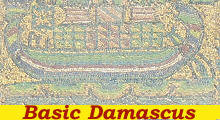 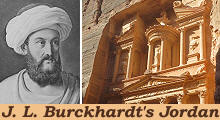 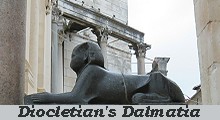 |
